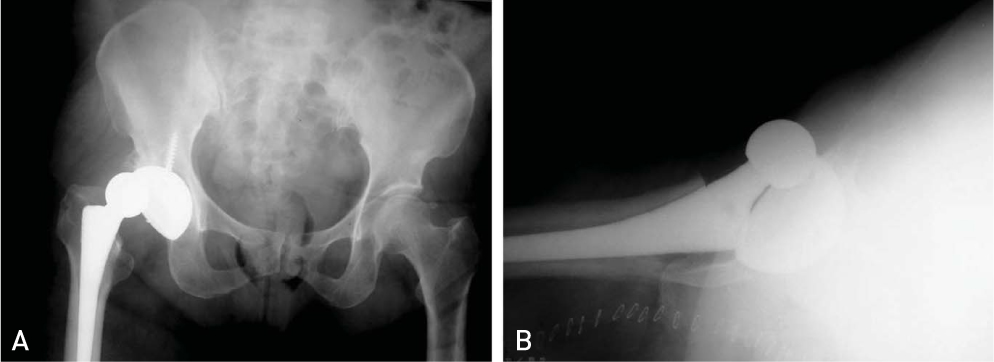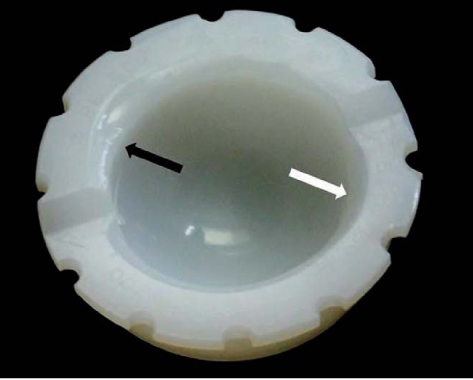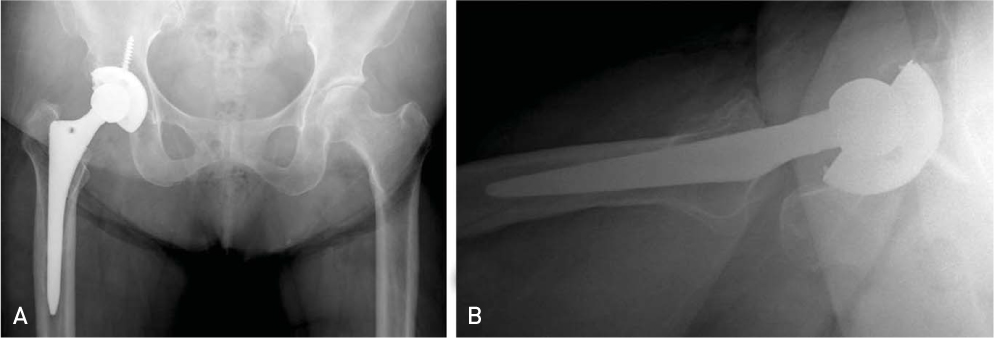Hip Pelvis.
2013 Dec;25(4):286-291. 10.5371/hp.2013.25.4.286.
Exchange and Reorientation of an Elevated-rim Polyethylene Liner for the Recurrent Anterior Subluxation after Total Hip Arthroplasty: A Case Report
- Affiliations
-
- 1Department of Orthopaedic Surgery, Pusan National University Yangsan Hospital, Pusan National University School of Medicine, Yangsan, Korea. kuentak@pusan.ac.kr
- KMID: 1808137
- DOI: http://doi.org/10.5371/hp.2013.25.4.286
Abstract
- Total hip arthroplasty for osteoarthritis of the right hip was performed in a 62-year-old female patient with right-side weakness due to cerebral infarction. Because the second cerebral infarction aggravated right-side weakness, recurrent anterior subluxation occurred two years after surgery. We report on a case of recurrent anterior subluxation of total hip arthroplasty, which was treated successfully by exchange and reorientation of an elevated-rim polyethylene, and discuss studies reporting on recurrent subluxation after total hip arthroplasty and its treatment.
MeSH Terms
Figure
Reference
-
1. Liaw CK, Yang RS, Hou SM, Wu TY, Fuh CS. Measurement of the acetabular cup anteversion on simulated radiographs. J Arthroplasty. 2009; 24:468–474.
Article2. Charnley J. Low friction arthroplasty of the hip: theory and practice. 1st ed. New York: Springer;1979.3. Cobb TK, Morrey BF, Ilstrup DM. The elevated-rim acetabular liner in total hip arthroplasty: relationship to postoperative dislocation. J Bone Joint Surg Am. 1996; 78:80–86.4. Bosco JA, Benjamin JB. Loosening of a femoral stem associated with the use of an extended-lip acetabular cup liner. A case report. J Arthroplasty. 1993; 8:91–93.
Article5. Murray DW. Impingement and loosening of the long posterior wall acetabular implant. J Bone Joint Surg Br. 1992; 74:377–379.
Article6. Graham GP, Jenkins AI, Mintowt-Czyz W. Recurrent dislocation following hip replacement: brief report. J Bone Joint Surg Br. 1988; 70:675.
Article7. Lewinnek GE, Lewis JL, Tarr R, Compere CL, Zimmerman JR. Dislocations after total hip-replacement arthroplasties. J Bone Joint Surg Am. 1978; 60:217–220.
Article8. Saadat E, Diekmann G, Takemoto S, Ries MD. Is an algorithmic approach to the treatment of recurrent dislocation after THA effective? Clin Orthop Relat Res. 2012; 470:482–489.
Article9. Lachiewicz PF, Soileau E, Ellis J. Modular revision for recurrent dislocation of primary or revision total hip arthroplasty. J Arthroplasty. 2004; 19:424–429.
Article
- Full Text Links
- Actions
-
Cited
- CITED
-
- Close
- Share
- Similar articles
-
- Comparison Between Standard and elevated-rim Acetabular Liner in Total Hip Arthroplasty
- Finite Element Analysis of Stress Distribution in Flat and Elevated-Rim Polyethylene Acetabular Liners
- An Inguinal Mass associated with Polyethylene Wear Debris after a Total Hip Arthroplasty: A Case Report
- Ceramic Head Fracture in Ceramic-on-Polyethylene Total Hip Arthroplasty
- Failure of a Metal Femoral Head after Revision Total Hip Arthroplasty for a Ceramic Liner Fracture






